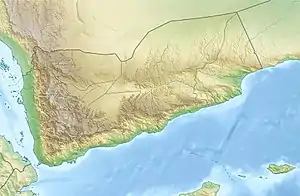Battle of Sa'dah
The Battle of Sa'dah erupted in March 2011 between Houthi insurgents and tribal forces loyal to Yemeni President Ali Abdullah Saleh in the northern city of Sa'dah. Following days of heavy clashes, the Houthis managed to capture the entire Sadah governorate including its provincial capital and establishes an independent administration, thereby marking the first such Yemeni governorate to fell out from central government control since the nationwide uprising began in 2011.
| Battle of Sa'dah | |||||||||
|---|---|---|---|---|---|---|---|---|---|
| Part of the Houthi insurgency in Yemen and the Yemeni Revolution | |||||||||
 Sadah city, where the fighting took place | |||||||||
| |||||||||
| Belligerents | |||||||||
|
| ||||||||
| Commanders and leaders | |||||||||
|
|
| ||||||||
| Casualties and losses | |||||||||
| 45 killed[1] | |||||||||
 Location within Yemen | |||||||||
Background
In February 2011, after the success of the 2011 Egyptian Revolution and Tunisian Revolution, the Arab Spring spread to many countries including Yemen. The Houthis, officially known as Ansar Allah, declared their support for the 2011 Yemeni uprising against Ali Abdullah Saleh and large crowds of Houthi followers joined the protests on their 10th day.[2] During February and March, thousands of protesters held weekly marches in Sa'dah city from the gates of the old city to the security barracks of Saleh's army.[3]
Meanwhile, skirmish clashes reportedly broke out as early as January on the outskirts of Sa'dah city between the Houthis and the Al Abdin tribe led by Sheikh Uthman Mujalli, a vocal anti-Houthi tribal leader. Mujalli was also a parliamentary representative from Sa'dah governorate representing the ruling General People’s Congress party. A few weeks after the clashes started, the student protest movement that began in the capital Sana'a soon spread to other parts of Yemen. Houthi rebels then began laying siege to Mujalli and his followers. Sa'dah provincial government later came under increasing pressure as anti-government protests grew as well as gradual local security collapse.[4]
Storming of Sa'dah
On 18 March, government snipers fired on a mass protest in the Yemeni capital Sana'a which prompted nationwide outrage and a flood of defections from the government known as the "Karama Massacre".[5]
In response to the bloody event, Houthi fighters stormed Sa'dah city next day on 19 March, allegedly blowing up houses and inflicting heavy civilian casualties.[6] This led to a heavy conflict with the Al Abdin tribes in which 45 people were killed and 13 houses were destroyed. Houthis then attacked the Telmus military site, overlooking the city and captured numerous machine guns, mortar shells, guns and tanks. Houthis prevailed in the fighting and burned down Sheikh Mujalli's house, destroying all his possessions and seizing sixteen cars.[1] Sa'dah governor Taha Hajer then fled the province to Sana'a[7] and police deserted their posts,[8] after which all the leaders of the Sa'dah army headquarters handed over their military equipment and bases to the Houthi group.[7]
By 27 March, Houthi rebels were in full control of the city,[1] running all the government facilities and control checkpoints[8] and controlling all entrances to the city.[1]
Aftermath
On 26 March,[7] Houthi field commander Abu Ali al-Hakim appointed Fares Mana'a, one of the Middle East's most prominent arms dealers and former ally to Saleh, as governor of Sa'dah. Mana'a broke with Saleh after he had been imprisoned by him for months in Sana'a and he resigned from GPC party to join forces with the Houthis along with several other prominent Sa'dah politicians.[1] Houthis later declared a separate administration fully independent from the government of Yemen,[7] consisting of rebels, residents and defected military commanders.[9]
The Houthi takeover of Sa'dah resulted in over one and half year of relative peace and stability in the governorate.[10] Since then, Sa'dah governorate also becomes famously known as the Houthi stronghold where prominent leaders such as Abdulmalik al-Houthi is believed to be residing there.[11]
References
- Houthis Control Sa’ada, Help Appoint Governor
- Press TV Houthis join protests in north Yemen, February 22, 2011
- Yemeni Uprising Opens a Door to Besieged Rebels in the North, December 16, 2011
- https://ctc.usma.edu/posts/yemens-huthi-movement-in-the-wake-of-the-arab-spring
- http://www.counterfire.org/international/15634-yemen-remembering-the-friday-of-dignity-
- Sa'ada: A Cry for Help
- Houthi Group Appoints Arms Dealer as Governor of Sa'ada province
- Yemeni regime loses grip on four provinces
- The Washington Post Yemen crisis intensifies with factory explosion, March 29, 2011
- Anti-U.S. rebels’ triumph in northern Yemen brings peace to embattled region, October 25, 2012
- Yemen's 'Death to America' rebels bring calm to northern Yemen, October 28, 2012